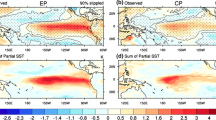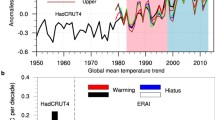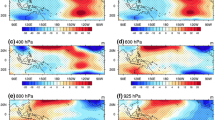Abstract
Energetic feedbacks play important roles during the El Niño-Southern Oscillation (ENSO). Here we conduct a thorough analysis of the radiative and non-radiative vertical fluxes and compare them to horizontal energy transport to provide a complete view of the energetics of ENSO. Our analyses affirm that cloud feedbacks are the most important radiative feedbacks, with cloud shortwave (SW) and longwave (LW) feedbacks dominating at the surface and in the atmosphere respectively. Oceanic energy transport dominates the oceanic heat content change in the developing phase and has significant effects on the sea surface temperature (SST) about 6 months earlier than vertical fluxes. Atmospheric horizontal energy transport is also important, acting to quickly remove the surplus of energy provided by the convergence of vertical energy fluxes in the atmosphere. The differential diabatic heating between the Central Pacific and the Warm Pool, induced by the latent heat release as well as LW radiation, strengthens the anomalous circulation and reinforces the Bjerknes positive feedback to strengthen the SST anomaly. This work reveals that the differential heating is more strongly correlated with the SST anomaly in the Central Pacific than the local SW negative feedback of clouds and supports the idea that the overall atmospheric effect is likely a positive feedback that acts to strengthen ENSO.







Similar content being viewed by others
References
Allan RP, Slingo A, Ringer M (2002) Influence of dynamics on the changes in tropical cloud radiative forcing during the 1998 El Niño. J Clim 15:1979–1986
Bayr T, Dommenget D, Martin T, Power SB (2014) The eastward shift of the Walker Circulation in response to global warming and its relationship to ENSO variability. Clim Dyn 43:2747–2763
Bellenger H, Guilyardi É, Leloup J, Lengaigne M, Vialard J (2014) ENSO representation in climate models: from CMIP3 to CMIP5. Clim Dyn 42:1999–2018
Bjerknes J (1966) A possible response of the atmospheric Hadley circulation to equatorial anomalies of ocean temperature. Tellus 18:820–829
Bony S, Bellon G, Klocke D, Sherwood S, Fermepin S, Denvil S (2013) Robust direct effect of carbon dioxide on tropical circulation and regional precipitation. Nat Geosci 6:447–451
Bony S, Dufresne JL (2005) Marine boundary layer clouds at the heart of tropical cloud feedback uncertainties in climate models. Geophys Res Lett. https://doi.org/10.1029/2005GL023851
Cess RD, Zhang M, Wielicki BA, Young DF, Zhou X-L, Nikitenko Y (2001) The influence of the 1998 El Niño upon cloud-radiative forcing over the Pacific warm pool. J Clim 14:2129–2137
Cheng L, Trenberth KE, Fasullo J, Boyer T, Abraham J, Zhu J (2017) Improved estimates of ocean heat content from 1960 to 2015. Sci Adv 3(3):e1601545
Cheng L, Trenberth KE, Fasullo JT, Mayer M, Balmaseda M, Zhu J (2019) Evolution of ocean heat content related to ENSO. J Clim 32:3529–3556
Chiang JC, Sobel AH (2002) Tropical tropospheric temperature variations caused by ENSO and their influence on the remote tropical climate. J Clim 15:2616–2631
Dee DP et al (2011) The ERA-Interim reanalysis: configuration and performance of the data assimilation system. Q J R Meteorol Soc 137:553–597
Dessler A (2013) Observations of climate feedbacks over 2000–10 and comparisons to climate models. J Clim 26:333–342
Dessler AE (2010) A determination of the cloud feedback from climate variations over the past decade. Science 330:1523–1527
Guilyardi E, Braconnot P, Jin F-F, Kim ST, Kolasinski M, Li T, Musat I (2009) Atmosphere feedbacks during ENSO in a coupled GCM with a modified atmospheric convection scheme. J Clim 22:5698–5718
Guilyardi E et al (2004) Representing El Nino in coupled ocean–atmosphere GCMs: the dominant role of the atmospheric component. J Clim 17:4623–4629
Hersbach H et al (2020) The ERA5 global reanalysis. Q J R Meteorol Soc 146:1999–2049
Huang Y, Xia Y, Tan X (2017) On the pattern of CO2 radiative forcing and poleward energy transport. J Geophys Res Atmos 122:10578–10593
Huffman GJ, Adler RF, Bolvin DT, Nelkin EJ (2010) The TRMM multi-satellite precipitation analysis (TMPA). In: Satellite rainfall applications for surface hydrology. Springer, pp 3–22
Klein SA, Soden BJ, Lau N-C (1999) Remote sea surface temperature variations during ENSO: evidence for a tropical atmospheric bridge. J Clim 12:917–932
Kobayashi S et al (2015) The JRA-55 reanalysis: general specifications and basic characteristics. J Meteorol Soc Jpn Ser II 93:5–48
Kolly A, Huang Y (2018) The radiative feedback during the ENSO cycle: observations versus models. J Geophys Res Atmos 123:9097–9108
Liu Z, Alexander M (2007) Atmospheric bridge, oceanic tunnel, and global climatic teleconnections. Rev Geophy. https://doi.org/10.1029/2005RG000172
Lloyd J, Guilyardi E, Weller H (2011) The role of atmosphere feedbacks during ENSO in the CMIP3 models. Part II: using AMIP runs to understand the heat flux feedback mechanisms. Clim Dyn 37:1271–1292
Lloyd J, Guilyardi E, Weller H (2012) The role of atmosphere feedbacks during ENSO in the CMIP3 models. Part III: the shortwave flux feedback. J Clim 25:4275–4293
Lloyd J, Guilyardi E, Weller H, Slingo J (2009) The role of atmosphere feedbacks during ENSO in the CMIP3 models. Atmos Sci Lett 10:170–176
Loeb NG et al (2018) Clouds and the earth’s radiant energy system (CERES) energy balanced and filled (EBAF) top-of-atmosphere (TOA) edition-4.0 data product. J Clim 31:895–918
Mayer M, Haimberger L, Edwards JM, Hyder P (2017) Toward consistent diagnostics of the coupled atmosphere and ocean energy budgets. J Clim 30:9225–9246
Mayer M, Trenberth KE, Haimberger L, Fasullo JT (2013) The response of tropical atmospheric energy budgets to ENSO. J Clim 26:4710–4724
Middlemas EA, Clement AC, Medeiros B, Kirtman B (2019) Cloud radiative feedbacks and El Niño-Southern oscillation. J Clim 32:4661–4680
Pinker R, Grodsky S, Zhang B, Busalacchi A, Chen W (2017) ENSO impact on surface radiative fluxes as observed from space. J Geophys Res Oceans 122:7880–7896
Rädel G, Mauritsen T, Stevens B, Dommenget D, Matei D, Bellomo K, Clement A (2016) Amplification of El Niño by cloud longwave coupling to atmospheric circulation. Nat Geosci 9:106
Radley C, Fueglistaler S, Donner L (2014) Cloud and radiative balance changes in response to ENSO in observations and models. J Clim 27:3100–3113
Roemmich D, Gilson J (2011) The global ocean imprint of ENSO. Geophys Res Lett 38
Sardeshmukh PD, Hoskins BI (1984) Spatial smoothing on the sphere. Mon Weather Rev 112:2524–2529
Shell KM, Kiehl JT, Shields CA (2008) Using the radiative kernel technique to calculate climate feedbacks in NCAR’s Community Atmospheric Model. J Clim 21:2269–2282
Soden BJ, Broccoli AJ, Hemler RS (2004) On the use of cloud forcing to estimate cloud feedback. J Clim 17:3661–3665
Stephens GL (2005) Cloud feedbacks in the climate system: a critical review. J Clim 18:237–273
Su H, Jiang JH (2013) Tropical clouds and circulation changes during the 2006/07 and 2009/10 El Niños. J Clim 26:399–413
Sun D-Z (2000) The heat sources and sinks of the 1986–87 El Niño. J Clim 13(20):3533–3550
Sun D-Z, Fasullo J, Zhang T, Roubicek A (2003) On the radiative and dynamical feedbacks over the equatorial Pacific cold tongue. J Clim 16:2425–2432
Sun D-Z, Yu Y, Zhang T (2009) Tropical water vapor and cloud feedbacks in climate models: A further assessment using coupled simulations. J Clim 22:1287–1304
Sun D-Z et al (2006) Radiative and dynamical feedbacks over the equatorial cold tongue: results from nine atmospheric GCMs. J Clim 19:4059–4074
Sun D-Z, Trenberth KE (1998) Coordinated heat removal from the equatorial Pacific during the 1986–87 El Nino. Geophys Res Lett 25:2659–2662
Trenberth KE, Caron JM, Stepaniak DP, Worley S (2002) Evolution of El Niño–Southern Oscillation and global atmospheric surface temperatures. J Geophys Res Atmos 107:AAC 5-1–AAC 5-17
Trenberth KE, Stepaniak DP (2003) Covariability of components of poleward atmospheric energy transports on seasonal and interannual timescales. J Clim 16:3691–3705
Waliser DE, Blanke B, Neelin JD, Gautier C (1994) Shortwave feedbacks and El Niño-Southern Oscillation: forced ocean and coupled ocean–atmosphere experiments. J Geophys Res Oceans 99:25109–25125
Wang H, Su W (2015) The ENSO effects on tropical clouds and top-of-atmosphere cloud radiative effects in CMIP5 models. J Geophys Res Atmos 120:4443–4465
Xia Y, Huang Y (2017) Differential radiative heating drives tropical atmospheric circulation weakening. Geophys Res Lett 44:10592–10600
Zhang T, Sun D-Z (2008) What causes the excessive response of clear-sky greenhouse effect to El Niño warming in community atmosphere models? J Geophys Res Atmos. https://doi.org/10.1029/2007JD009247
Acknowledgements
The ERAI data used in this research can be accessed from https://apps.ecmwf.int/datasets/data/interim-full-moda/levtype=sfc/. The JRA55 dataset can be accessed from https://rda.ucar.edu/datasets/ds628.0/. The ERA5 dataset is from https://cds.climate.copernicus.eu/-!/search?text=ERA5&type=dataset. The CERES data is from https://ceres.larc.nasa.gov/order_data.php. The TRMM data can be accessed from https://disc.gsfc.nasa.gov/datasets/TRMM_3B43_7/summary. The radiative kernel data from Yi Huang’s homepage (https://huanggroup.wordpress.com/research/). HH acknowledges a visiting student fellowship provided by China Scholarship Council (CSC) that supported her visit to McGill University where this research is conducted. YH acknowledges a grant from the Natural Sciences and Engineering Research Council of Canada (RGPIN-2019-04511). YYH acknowledges the National Natural Science Foundation of China under grants of 41530423 and 41761144072.
Author information
Authors and Affiliations
Corresponding author
Additional information
Publisher's Note
Springer Nature remains neutral with regard to jurisdictional claims in published maps and institutional affiliations.
Electronic supplementary material
Below is the link to the electronic supplementary material.
Rights and permissions
About this article
Cite this article
Huang, H., Huang, Y. & Hu, Y. Quantifying the energetic feedbacks in ENSO. Clim Dyn 56, 139–153 (2021). https://doi.org/10.1007/s00382-020-05469-y
Received:
Accepted:
Published:
Issue Date:
DOI: https://doi.org/10.1007/s00382-020-05469-y




